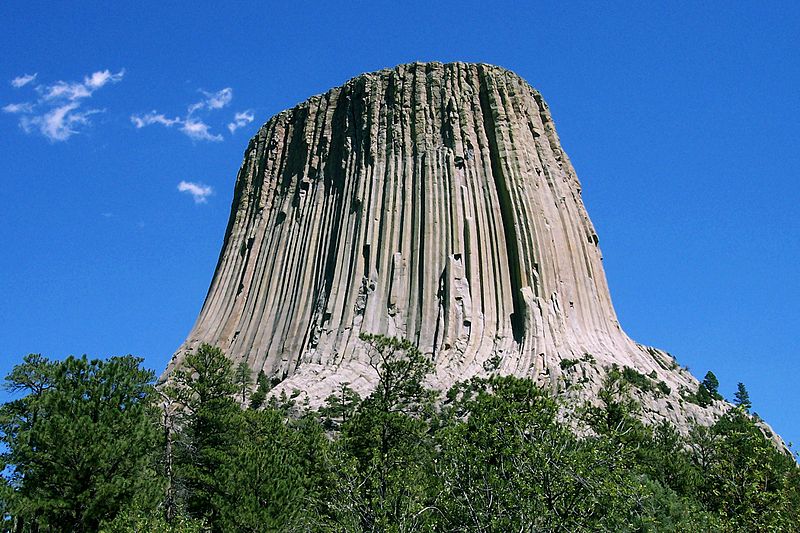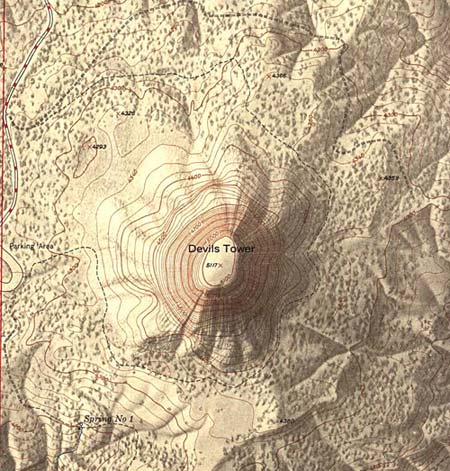Strange rocks in nature
Nature is amazing and always gives people a lot of surprises sometimes seem impossible to explain. In many parts of the world, people discovered rocks with extremely strange shapes. Many of them are worshiped by the people, putting them in great religious beliefs.
The most bizarre rocks on the planet
1. Devil's Tower in Wyoming, USA
It is a giant basalt rock up to 280m high, formed from volcanic lava, which is gradually formed by wind and erosion.
According to scientists, in the last eruption of volcanoes, the propulsion is too weak to make lava escape from the mountain's mouth to spill out. Lava lies right at the crater, forming a knot; It takes tens of years, this piece of stoppers cools down into hard rock: basalt. After a long time, wind and rain eroded the volcanic slopes, gradually reaching this cold lava layer. The nature of this lava layer is homogeneous and rare, and when it is cooled, it is invaded to create polygonal pillars, arranged in parallel with each other vertically like a giant set in the cathedral, so they are named ' the basalt stone '.

(Photo: terragalleria)

(Photo: lib.utexas.edu)
2. The path of the giant in Ireland
The area of Antrim, Northern Ireland, tens of thousands of pillars of rock that plugged themselves into the ground, stretching out to the sea. They are multi-faceted stone pillars with 5, 6, 7 or 8 faces that have long been in the Irish legend with the name 'Giant's causeway'. They say that the giants built this road, opening a passage across the sea. Scientists have studied and said that 60 million years ago, this land is a volcanic area, magma layer from the volcanic heart rises through the grooves to the outside into layers of tens of meters thick. They cool down over thousands of years, shrinking themselves, creating stone columns with large crystals with polygons, higher than 2m. Due to its proximity to the sea, these solid basalt columns were struck by the waves, gradually invading, eventually creating giant cylindrical terraces arranged in no order.

(Photo: gaschurman.com)
3. Giant stone mushroom in California state, USA
With a strange shape that resembles a mushroom, it has a flat, smooth bottom while the upper part is angular. This strange rock is located in the Death Valley of California (USA). Wind and water participated in shaping this stone. According to geologists, it was originally sedimentary rock, scattered here and there in the area. With desert climate, the wind picks up sand grains in which there are very hard quartz crystal particles smashing into the rock, rubbing on its lower part, sometimes sand rising up to 2m high, causing abrasion and hitting. shadow of the foot of the rock; Long time making stone block has the shape of a strange mushroom.

(Photo: nau.edu)

(Photo: dennis-jackson.me.uk)
4. Devil marbles in Australia
People in southwest Australia call this ' demon marbles '. With the shape of two round stones standing on the rocks, in a very stable balance position. In the world, one can also find stones standing in such stable positions in many places like Zimbabwe or Hon Chong in Vietnam. But hardly any stone is trimmed roundly like Australia's 'demons' with a standing position too high and weighing more than a dozen tons.
According to scientists, initially in the Earth's crust during the cooling and shifting process, giant rocks of the earth formed; water penetrates into the soil through cracks. The hot and humid climate changes over time, the rain fills and creates rivers, the river swept away soft soil, stones, pebbles and sand, and the remaining two rocks are too large to be swept away. . Over time, two stones stood in balance, eroded, smoothed by sand and wind.

(Photo: anu.edu.au)
5. Floating stones in Turkey
In the Cappadoce area (Turkey), the guest zone can admire the rocks suspended above the giant blocks of very stable rocks. People in this region call them ' angelic steps'.
At first, the volcano erupted a series of lava, melting all the things around the volcano's flank, accompanied by ash and stones fired. All of these materials combine over time to form a soft layer that stretches along the mountainside. Next, the second lava eruption, shot with large rocks, formed a second flow over the original layer. Over time, rain, rivers, waterfalls eroded this second layer, carved into ditches, bringing soft rocky ground towards the valley and the flow continued to deepen into the original soft layer. Gradually, only huge hard rocks remain, with stones on it (originating from volcanoes). So formed floating stones - ' angel's steps '.

(Photo: linternaute)
6. Huge rock split apple - New Zealand
In South New Zealand Abel Tasman National Park has a lot of interesting rocks, but the giant stone apple is the most interesting rock among the rocks here, this rock lies above sea level. of Tasman Bay. The crack between this rock is so neat and sharp that others must think that someone deliberately divided it with a saw.

7. Hon Kjeragbolten
It is a smooth stone lying between the fissures of the two mountains on the Kjerag range in Norway, Kjeragbolten means 'that' of Kjerag. Tourists come here often to stand on the strange stone, but no one is brave enough to stand and face down the deep abyss - 1,000 meters before touching the Lysefjorden glacier.

Photo: krfilm.net
8. Stone worship
Somehow, the 200-ton stone block has a shape that looks like a car… this hambuger can stand on the tiny rock below. That's why it became the most visited attraction in northern Yorshire, England.

Photo: krfilm.net
- Mysterious strange circular rocks in nature
- Strange rocks in Vietnam
- The most exotic rocks in the world
- Mysterious valley with strange rocks like straying to another planet
- Discovered drifting rocks in exotic seas in the Pacific Ocean
- The mystery of rocks
- Suspicious object is cannon cannon on Mars
- Strange rocky rock rang like an instrument
- Mysteriously from walking rocks
- 19 mysterious natural phenomena challenging science
- Strange to see ... specialty
- Controversy about the mysterious stone beach
 Is the magnetic North Pole shift dangerous to humanity?
Is the magnetic North Pole shift dangerous to humanity? Washington legalizes the recycling of human bodies into fertilizer
Washington legalizes the recycling of human bodies into fertilizer Lightning stone - the mysterious guest
Lightning stone - the mysterious guest Stunned by the mysterious sunset, strange appearance
Stunned by the mysterious sunset, strange appearance